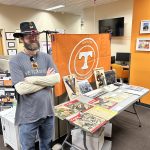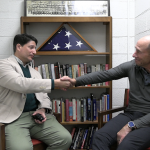American Civil War Records
Robert Atherly (Union) Documents
Sergeant Robert Atherly was born in Scotland and later immigrated to the United States, where he enlisted in Company G of the 79th New York Infantry on May 28, 1861. Known as the “Highlanders,” the 79th was a proud Scottish-American regiment celebrated for its discipline, bravery, and distinctive tartan heritage. Atherly rose through the ranks and was promoted to sergeant on November 1, 1863, earning the respect of his fellow soldiers. Though fighting far from his homeland, he served with valor in several key campaigns across the South. He was killed in action during the Battle of Fort Sanders in Knoxville on November 29, 1863, his service remembered as part of the storied legacy of the 79th Highlanders.
Dr. John Mason Boyd (Confederacy) Documents
Dr. John Mason Boyd is remembered as one of Knoxville’s most prominent physicians. He was a surgeon for the Confederate Army during the Civil War. After the war, he was the University of Tennessee’s physician for forty years, as well as a trustee for the Tennessee School for the Deaf. Dr. Boyd practiced medicine in Knoxville for 53 years and had an arch erected in his honor by a group of patients in 1911. The arch stands at 300 Main St SW in Knoxville, TN.
Alexander C. Caldwell (Union) Documents
Private Alexander C. Caldwell was born on March 26, 1842, in Tennessee and enlisted in the Union Army’s 3rd Tennessee Infantry Regiment on February 12, 1862, at Flat Lick, Kentucky. Serving with a regiment made up largely of loyal East Tennesseans, he took part in operations around Cumberland Gap, a key gateway between Tennessee, Kentucky, and Virginia. Alexander died on September 1, 1862, during the (brief) Union occupation of the Cumberland Gap, as disease and hardship claimed many soldiers in the rugged mountain stronghold. His death was recorded in the regimental muster rolls, and he was later re-interred in the Knoxville National Cemetery, Section B, Site 3149. Honored posthumously, Caldwell’s brief but faithful service reflects the courage and sacrifice of Tennesseans who fought to preserve the Union.
Tinbrook Chamberlain Baker (Union Army) Documents
Private Tinbrook Chamberlain Baker was born in Monroe, Michigan, in 1834 and lived there with his family before enlisting in the Union Army during the Civil War. He served bravely in Company A of the 8th Michigan Cavalry, a regiment noted for its service in Kentucky and Tennessee. Mustered in on December 30, 1862, Baker participated in campaigns leading up to the Battle of Knoxville. He died in Knoxville, Tennessee, of dysentery in 1863 at General Hospital No. 2, a facility now known as the Tennessee School for the Deaf. He is buried in Knoxville National Cemetery, where his service and sacrifice are memorialized among his fellow Union soldiers.
Joseph Alexander Cooper (Union) Documents
Brevet Major General Joseph Alexander Cooper was a Kentucky-born Union officer who made his name as a hard-fighting leader during the American Civil War. He began his service in 1861, organizing the 1st Tennessee Infantry, and earned the nickname “Fighting Joe” for his bravery in battles such as Mill Springs, Stones River, Chickamauga, the defense of Knoxville, and the Atlanta Campaign. Rising through the ranks to command a division in the XXIII Corps, he was brevetted major general for gallantry and meritorious service. Years later, Cooper returned to duty during the Spanish–American War, serving as a brigadier general of volunteers, where his long military experience was once again called upon by the nation. He died in 1910 and was laid to rest in Knoxville, Tennessee, remembered as a soldier whose career spanned two of America’s defining wars.
Samuel “Champ” Ferguson (Confederacy) Documents
Samuel “Champ” Ferguson was from Clinton County, Kentucky, but moved to White County, Tennessee, before the Civil War. He ran a group of guerrilla fighters who were loosely connected with the Confederacy. They were infamous for stealing horses and killing nearly 120 men across Tennessee throughout the war, including wounded soldiers at a Union Field Hospital after the Battle of Saltville. He was captured in August 1865 by Union soldiers, tried for his crimes, and executed on October 25th, 1865.
Daniel Marvin Foster (Confederate Army) Documents
Private Daniel Marvin Foster was born in 1824 in Tuscaloosa County, Alabama. He enlisted in the Confederate Army on May 16, 1862, joining Company H of the 43rd Alabama Infantry Regiment, which fought in several key battles of the Western Theater during the Civil War. Foster was killed in action in 1863 during the Battle of Knoxville, Tennessee, where his regiment took heavy losses. He was buried at Bethel Cemetery in Knoxville, alongside many of his fallen comrades. Coming from a family with a proud military tradition, Foster’s relatives had previously served in the War of 1812, continuing a legacy of Southern military service across generations.
Ellis Harper (Confederate Army) Documents
Captain Ellis Harper was born in what is now Portland, Tennessee, in 1842. He enlisted in Company 1 of the 30th Tennessee Infantry Regiment of the Confederacy. His regiment was captured by Ulysses S Grant at the Battle of Fort Donnelson, after which he escaped his Union Prison and formed a guerrilla band to invade the North, where he ravaged Kentucky and parts of Ohio before turning himself in near the end of the war in 1865. After a brief prison stint, he gave birth to John Booth Harper and lived a fairly normal life before being shot and killed after a political argument in 1908.
John Wesley Legg (Confederate Army) Documents
John Wesley Legg was the original owner of the Legg-England house, built in 1846, located at 8010 Rutledge Pike, Knoxville. The home served as an inn, tavern, and stagecoach stop — a key location because Rutledge Pike was a stagecoach route to Washington, D.C. When the Civil War came around, the home was passed to his daughter and her husband, Payne, and Mary Jane England. The house was rumored to be used as a hospital and a possible command post for either the Union or Confederate armies. No matter which it was, the family appears to be confederates, as a few of Legg’s sons were a part of a raid where they stole multiple horses from Union men. There is also the incident of William, Adam, and James being suspected of shooting George Majors near his country home in 1865. The motives for this murder were partially for money and political revenge. The financial aspect may have been fueled by their father’s issues with debt, as evidenced by a sheriff’s sale of his property to John Tunnell.
William Price Sanders (Union Army)
William Price Sanders was born in Kentucky in 1833. He went to West Point and was dismissed by Robert E. Lee, but was saved from dismissal by Jefferson Davis, who was his cousin. Ironically, despite his strong connections to major Confederate Leadership, he became a Union hero in the Civil War. He was chosen by Ambrose Burnside to command the Army of the Ohio after his heroics at the Battle of Antietam. In 1863, leading the Army of the Ohio, he tore from Kentucky into East Tennessee, destroying railroad lines, burning railroad bridges, cutting telegraph wires, and seizing artillery, leading up to Knoxville. He led the Army of the Ohio during the majority of the Knoxville Campaign until he was shot on November 18, 1863. Rumor has it that a sharpshooter poised at the top of the Bleak House, the Confederate headquarters of James Longstreet, fired and struck Sanders while he was poised at what is now Second Presbyterian Church. Although this is a legend, it is confirmed that he died at the Lamar House, now the Bijou Theatre on Gay Street, the next day. He was initially buried at Second Presbyterian Church before his body was exhumed and reburied at the Chattanooga National Cemetery. The Fort Sanders Neighborhood bears his name.
Timothy Spillane (Union Cavalry) Documents
Timothy Spillane was born in Ireland in 1842. Hardly any information is readily available on his arrival in the United States; however, it is known that he enlisted in the 16th Pennsylvania Cavalry and fought in the Battle of Hatcher’s Run, where he was twice wounded and continued fighting. It was for this bravery that President Rutherford B Hayes awarded him the Medal of Honor. He passed away in Knoxville on December 3, 1901, and was buried at Knoxville National Cemetery. He is one of two Medal of Honor recipients to be buried in Knoxville National Cemetery.



